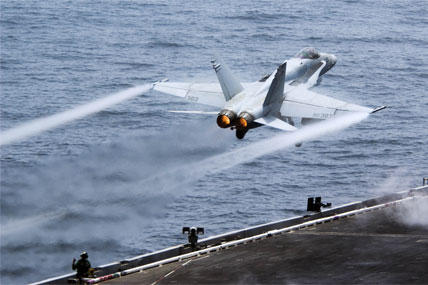The U.S. Navy is upgrading its F/A-18 fighter jets to improve the attack and fighter aircraft’s survivability, electronics package and overall performance to better combat potential threats, service officials said.
The improvements are taking place across the legacy Hornet fleet as well as the Super Hornet and Growler fleets. They include design work, engineering and enhancements to the avionics, sensors and helmet-mounted displays, weapons, targeting technologies and electronic warfare systems.
“The Navy continues to invest in capability upgrades to the entire Hornet, Super Hornet and Growler fleet to each aircraft’s maximum potential,” service officials with the F/A-18 and EA-18G program office said in an e-mail to Military.com.
A battle-tested workhorse in the naval inventory, the F/A-18 can travel at speeds faster than Mach 1.8 at altitudes of about 50,000 feet. The upgrades are designed to ensure the aircraft’s technological superiority against future adversaries.
Some analysts say the Navy’s push to upgrade the F/A-18 is a hedge against delays to the Pentagon’s Joint Strike Fighter program developing the F-35 Lightning II.
“Things with the JSF are much better than they were a year ago,” Richard Aboulafia, vice president of analysis at the Teal Group, said in an interview. “Now, things with the F-35C planes for the Navy, the big deck carrier variant, are going well. There’s a lot you can do with a Super Hornet. However, one thing you cannot give it is low-observability or ‘stealth’ capability.”
Aboulafia, an aviation expert, also said the F-35 brings a new generation of sensor fusion and integration into the cockpit with on-board and off-board sensors – a capability that is not equaled by any existing fighter aircraft.
Legacy Hornet upgrades consist of improving the communications and avionics s to Link 16, a high-speed, digital information link designed to exchange voice, images and data in real-time by using a radio frequency band from 960 to 1,215 megahertz.
Another system included in the upgrades is the so-called joint helmet mounted cueing system, a helmet-mounted display designed to help pilots and aircrews receive targeting information. The system works, in part, by aligning sensor information with the head-movements of the aircrew.
“Sensors aboard the aircraft can cue aircrew to potential targets,” Greg Hardy, the system’s program manager at Chicago-based Boeing Co., said in a written statement. “Conversely, aircrew can cue weapons and sensor systems to areas of interest, aiming radar, air-to-air missiles, infrared sensors and air-to-ground weapons by pointing their heads at the targets.”
The technology is engineered for both the legacy Hornet fleet as well as the Super Hornets, Hardy said.
Legacy Hornet upgrades will apply to the radar, electronic warfare suite, targeting system such as the advanced targeting forward looking infrared, and precision weapons, the program office said.
Super Hornet enhancements include a distributed targeting system, counter electronic attack, multi-sensor integration, advanced weapons, integrated defense electronic countermeasures and air-to-surface warfare.
Also, Super Hornet improvements also include infrared search and track, or IRST, a passive forward-looking infrared sensor designed to locate enemy aircraft such as fighter jets and helicopters. Unlike radar, for instance, IRST does not emit radiation and is therefore much harder to detect.
Lockheed Martin’s transportable IRST pod in February 2012 successfully acquired, tracked and provided a weapons cue during a live-fire flight test conducted by the Air National Guard, according to statement from the company.
“The IRST is immune to RF jamming in Electronic Attack scenarios,” Steve Farrow, director of business development for fixed-wing programs at Lockheed Martin, said in a written statement. “The system enhances survivability and lethality in both offensive and defensive counter-air roles and is a powerful tool for achieving air superiority.”
The Boeing-engineered distributed targeting system, or DTS, compares images taken from tactical sensors with an on-board imagery database to produce highly accurate target coordinates, according to Paul Tipton, Boeing’s chief architect for the F/A-18 and EA-18G flight plan.
“This system essentially takes sensor images and fuses them with geo-referenced images and digital terrain data which reside in the on-board memory to give the aircrew significantly more precise targeting and accuracy,” Tipton said in a written statement.
The system generates real-time, reactive and precision target coordinates at maximum weapon delivery ranges, processes it with on-board data and enhances the measured accuracy of the aim point, Tipton said. It’s in production and will be fully operational across the Navy’s Super Hornet fleet later this summer, he said.





























